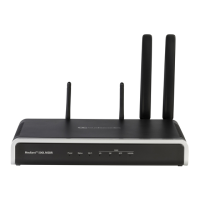User's Manual 862 Document #: LTRT-10466
Mediant 500L MSBR
Parameter Description
[NumberOfActiveDialogs]
Defines the maximum number of concurrent, outgoing SIP
REGISTER dialogs. This parameter is used to control the
rate.
The valid range is 1 to 20. The default is 20.
Notes:
Once a 200 OK is received in response to a REGISTER
message, the REGISTER message is not considered in this
maximum count limit.
This parameter applies only to outgoing REGISTER messages
(i.e., incoming is unlimited).
EMS: Transparent Coder On
Data Call
[TransparentCoderOnDataCall
]
[0] = (Default) Only use coders from the coder list.
[1] = Use Transparent coder for data calls (according to RFC
4040).
The Transparent coder can be used on data calls. When the device
receives a Setup message from the ISDN with 'TransferCapabilities
= data', it can initiate a call using the coder 'Transparent' (even if the
coder is not included in the coder list).
The initiated INVITE includes the following SDP attribute:
a=rtpmap:97 CLEARMODE/8000
The default payload type is set according to the CodersGroup
parameter. If the Transparent coder is not defined, the default is set
to 56. The payload type is negotiated with the remote side, i.e., the
selected payload type is according to the remote side selection. The
receiving device must include the 'Transparent' coder in its coder list.
Network Node ID
net-node-id
[NetworkNodeId]
Defines the Network Node Identifier of the device for Avaya UCID.
The valid value range is1 to 0x7FFF. The default is 0.
Notes:
To use this feature, you must set the parameter to any value
other than 0.
To enable the generation by the device of the Avaya UCID value
and adding it to the outgoing INVITE sent to the IP Group (Avaya
entity), use the IP Group table's parameter 'UUI Format'.
Web/EMS: Default Release
Cause
CLI: dflt-release-cse
[DefaultReleaseCause]
Defines the default Release Cause (sent to IP) for IP-to-Tel calls
when the device initiates a call release and an explicit matching
cause for this release is not found.
The default release cause is NO_ROUTE_TO_DESTINATION (3).
Other common values include NO_CIRCUIT_AVAILABLE (34),
DESTINATION_OUT_OF_ORDER (27), etc.
Notes:
The default release cause is described in the Q.931 notation and
is translated to corresponding SIP 40x or 50x values (e.g., 3 to
SIP 404, and 34 to SIP 503).
Analog: For more information on mapping PSTN release causes
to SIP responses, see Mapping PSTN Release Cause to SIP
Response on page 402.
When the Trunk is disconnected or is not synchronized, the
internal cause is 27. This cause is mapped, by default, to SIP
502.
For mapping SIP-to-Q.931 and Q.931-to-SIP release causes, see
Configuring Release Cause Mapping on page 397.
For a list of SIP responses-Q.931 release cause mapping, see

